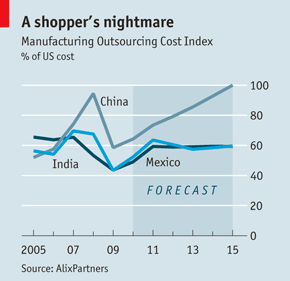Market analysis: Rising labor costs in China
Although constantly increasing labor costs are decreasing margins for many companies operating in China, rising labor costs alone is not enough to topple the country’s immense manufacturing industry. China currently accounts for about 1/5 of total global manufacturing, more than any other country in the world. Unfortunately for many foreign companies that have outsourced their labor to China, labor costs are not as low as they used to be and will continue to rise.
 Factors responsible for rising manufacturing costs
Factors responsible for rising manufacturing costs
In 2005, it was common for companies in the US to save about 25-30% on manufacturing by moving their plants to China. This number is no longer a reality as the gap in manufacturing costs has narrowed down to nearly one-third of what it once was. Although factors such as an increase in the value of Chinese currency, an increase in shipping costs, stricter environmental and safety regulations, and higher taxes have all contributed to the increase in Chinese manufacturing costs, labor remains the main factor for this increase. Labor costs have increased an average of 12% per year over the past decade and about 20% per year in the past four years. According to AlixPartners, a consulting firm, manufacturing costs in China could catch up to US manufacturing costs by 2015. Although this would require an annual increase of 30% in wages and a 5% rise in shipping costs, this could be a reality if manufacturers do not change their practices.
Adapting to changing Chinese market
Despite this increase in manufacturing costs, manufacturing is unlikely to leave the country anytime soon. According to Hal Sirkin of Boston Consulting Group, companies are unlikely to leave China due to the increasing demand from Chinese consumers. He estimates that Chinese domestic demand is increasing at about 8-10 percent per year. All manufacturers need to do is adjust their manufacturing plants to serve the needs of Chinese consumers rather than western consumers. In addition, China offers more reliable suppliers of services involved in the manufacturing process compared to other developing countries. Other problems such as less efficiency and a lack of reliable supply chains usually offset the 30% difference in labor costs between China and cheaper countries. Similarly, China’s inland infrastructure and logistics are not developed enough for manufacturers to move west. Only firms planning to serve customers in inland China are likely to move away from China’s bigger cities. Although many low-tech, labor-intensive industries may soon leave China or move inland, high-tech equipment will remain on China’s coastline. China’s immense labor pool is much more productive and flexible than those of other countries and it remains cheaper than manufacturing in developed countries. Until a country can match China in not only price, but also availability of resources, the manufacturing industry is unlikely to leave China.
Sources:
Daxue Consulting Market Analysis in China
Picture source: The Economist















